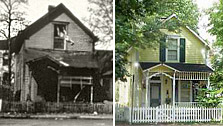
Introduction
Lockerbie Square, a quiet residential area about half a mile from the very center of Indianapolis, is rich in history and charm, with tree-lined streets, small homes, a few mansions, and a population of just over 400. It owes its beginnings to the shrewd investments of two enterprising families in the 1860’s. During the rest of the 19th century numerous skilled, thrifty, and immigrant artisans used their savings to build small homes on narrow lots close to the commercial center of Indianapolis. Several prosperous families built larger homes in the neighborhood, while three religious groups added substantial charitable institutions.
With the increase of commerce in the vicinity and economic changes following World War I, those who could afford to moved farther north, and, with one notable and lasting exception, the area fell into decline. Many of the homes were sold or abandoned, or became home to renters or boarders, few of whom had much interest in maintaining the neighborhood. In 1958 some residents and several city/county planning bodies and civic organizations began planning and work to restore or remodel many of the houses and streets, and to encourage the construction of new buildings that would both suit and enhance the neighborhood.
As a result of their determined and persistent efforts, the present of this decidedly pleasant residential spot in the city is bright, while its future seems secure.
Early Development
The neighborhood takes its name from George Murray Lockerbie, a Glaswegian who arrived here by way of Lexington, KY, in 1831 to join his daughter, Janet, and her husband, Thomas McOuat. The McOuats had purchased several lots from the city in 1821, and began to build a home in 1830. The name “Lockerbie,” which means “Loki’s Village” in Old Norse, comes from a large town south of Glasgow (site of the bombing of Pan American Flight 103 in December of 1988). An old bank building bearing the McOaut name still stands on East Washington St.. While both Lockerbie and McOuat prospered in the city’s early days, it was Lockerbie’s grand-daughter, Elizabeth Ann Butler and her husband who purchased “Out Lot 53” [presumably a lot outside the original mile square of the city] in 1846, and then sold it to her mother, now a widow.


Janet Lockerbie McOaut, apparently the canniest of the clan, platted out “McOuat’s Subdivision” in 1850. She divided the northern third into small house lots and reserved the undivided southern third, along New York Street, for the large house she shared with her children and, presumably, her father, who died in 1856. Several McOaut children built homes nearby, but the lots sold slowly at first, and the only houses to be built were on the south side of Lockerbie Street.
With the end of the civil war, economic and social conditions improved, and the Lockerbie neighborhood, with its central location and small lots, began to attract a good many artisans, clerks, and skilled laborers. Their thrift, good sense, and good taste established the character and the charm that now draw so many professionals, retirees, and other civic minded folk to the vicinity. The frame cottage that George Holler, a plasterer, for example, built at 324 North Park Ave. in 1863, restored in 1974-76 is one such example.


Between 1847 and 1860, Calvin Fletcher and his nephew, Timothyboth bankers and astute businessmenpurchased, subdivided, and developed the remaining three Out Lots in the original Lockerbie Square division. Many of these units were sold to German craftsmen and clerks, who either moved up from, or could not find housing in, the thriving “Germantown” neighborhood to the south, between Ohio and Market Streets. Some of the lots went to more prosperous buyers, such as the furniture manufacturers and retailers, August Spiegle and Friedrich Thoms, who built the substantial houses at 401 and 353 North Park Avenue. In 1860 Timothy Fletcher sold the southern third of the remaining Out Lot, the one in the north west corner of the neighborhood, to Mrs. Louisa Holt and her two sons, both clerks in Fletcher’s bank. The Holts built three substantial houses on their property south of Vermont St. (all razed in the 1960’s) and subdivided the rest of it into eleven more of the small lots that characterize the neighborhood.
